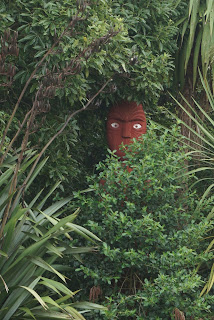The campsite reminds us of Spain with lots of pitches permanently occupied by old, slowly mouldering, caravans with sun-faded awnings. It a great working class gathering place - every day groups of friends are reunited and new groups form. It is noisier, brasher than Russell, people talk to each other more: we've heard several peoples accounts of visiting the UK. London, York, Oxford and Bath - a museum covering a whole country - but one person remembered my home city of Norwich which made me fleetingly nostalgic.
There is a safe bay to swim in. You can almost walk across. If you're lucky you might see an Orca - if you're very unlucky, one might see you! It has wonderful sunsets.
On Saturday the whole town seemed to turn out beside the river. The bridge has signs warning against jumping off which are casually ignored. On the banks children amost too young to walk totter into the water alongside siblings, parents, grandparents and probably great grandparents. Fresh fish sizzles on barbies, gazebos blow in the wind, teenagers go off in disgust to share their grievances about unreasonable parents. The sun shines and all is well with the world. Except that the sand is black rather than golden.
 |
| Black sand like a small Milky Way - with one step for mankind |
In the river a few couples are still swiming in the warm black water. We can hear their relaxed chat. The bridge supports are illuminated making it seem the elegant arch floats on beams of blue light. The light attracts insects which in turn brings shoals of fish which jump and roil the water.
On the other bank is a backpackers' and surfers' hostel. A different, slightly older group lounge around in the darkness, laughing and joking to the clink of bottles. Inevitably one young man sits apart from the rest practising his guitar.
Next stop is Vancouver, but this is a good place for a few days of quotidian contentment.
New Zealand is a garden,
And gardens are not made
By saying "Oh, how lovely!"
And sitting in the shade.
But the makers of the garden did a great job - so we can sit in the shade.
 |
| That sunset feeling. |










